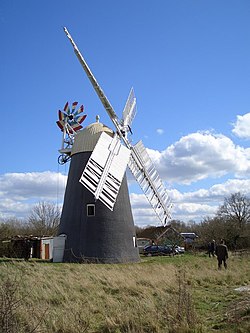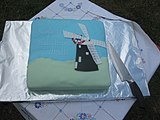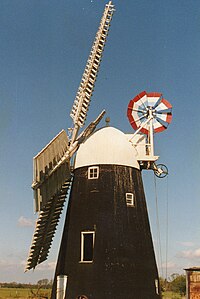Thelnetham Windmill
| Thelnetham Windmill | |
|
Suffolk | |
|---|---|
 The restored mill, photographed in 2006 | |
| Type: | Windmill |
| Location | |
| Grid reference: | TM011790 |
| Location: | 52°22’19"N, 0°57’18"E |
| History | |
| Built 1819 | |
| Windmill | |
| Information | |
| Owned by: | Thelnetham Mill Preservation Trust |
Thelnetham Windmill, also known as Button's Mill is a brick-built tower mill by Thelnetham in Suffolk. It was built in the early nineteenth century to grind wheat into flour. Thelnetham windmill worked by wind power until 1924, latterly on two sails, after which it became derelict. The mill is a Grade II* listed building.[1]
In 1979, a group of enthusiasts purchased Thelnetham windmill for restoration. Numerous volunteers helped to restore the mill to full working order over an eight-year period. The mill is open to the public, and flour ground at the mill can be bought at the site.
The mill is a small four storey tower mill with Patent sails and winded by a fantail. It drives two pairs of millstones, with a third pair driven by an auxiliary engine.
History
The earliest record of a windmill in Thelnetham was a post mill which was shown of Joseph Hodgkinson's map of Suffolk of 1778.[2] In 1818, the post mill was moved to Sandy Lane in Diss, Norfolk[3][4]
The post mill was replaced by a tower mill, which was built by millwright George Bloomfield for William Button in 1819. The mill was set to work on Christmas Day 1819.[5] In 1832, the mill was modernised by the fitting of a cast-iron windshaft, Patent sails and a fantail.[3] The new windshaft was fitted on 16 July 1832.[6] It was made by J Aickman, the King's Lynn millwright, and weighs 1¾ tons. A new stock was fitted in September 1836. William Button died on 11 February 1837. The mill passed jointly to his widow Rebecca and their son Richard.[5] Richard Button worked the mill until 1860, at which date it was conveyed to his sons Richard and William, who sold it to Richard Peverett from Kenninghall, Norfolk in 1862.[3]
The mill was worked by Stephen Peverett, Richard's son. He inherited the mill on the death of his father in 1875 and leased it to Henry Bryant in 1879. In 1884, the mill was sold by auction, and Henry Bryant purchased the freehold.[3] Bryant rebuilt the floors of the mill. From 1892, a portable steam engine was used as auxiliary power, driving an extra pair of millstones on the ground floor. This was replaced in 1914 by a Hornsby oil engine. Bryant ran the mill until 1920 when he sold it to Alphonso Vincent, a retired millwright from Garboldisham, Norfolk. The Hornsby engine was sold in the early 1920s. The mill was tailwinded c1920, and as a result one pair of sails was removed. Vincent carried out some repairs to the mill and ran it until he retired in 1924. One of the remaining two sails was wrecked in 1926 when the mill was again tailwinded (leaving the fantail unable to turn the mill into wind).
On the death of Alphonso Vincent in 1932, his son George inherited the property. He lived at the site in an old lorry until his death in 1973.[3] The mill passed to his daughter, who sold it in 1974 to Mr and Mrs Humphries,[5] who intended to convert it into a house. They later changed their minds and offered it for sale for restoration.[3] In 1976, the cap of the mill was blown to pieces in a gale.[7] Thelnetham windmill was purchased by five members of the Suffolk Mills Group in November 1979, and plans for restoration were made.[3] The consortium consisted of Mark Barnard, Charles Dolman, Peter Dolman, David Pearce and Chris Seago. The derelict mill and an acre of land cost £6,000.[8]

Restoration
In 2013, the mill was transferred as a gift to the Suffolk Building Preservation Trust, which also owns Pakenham Watermill.[9] On 14 July 2019, the bicentenary of the windmill was celebrated. The Locomobile lorry that George Vincent had lived in, now restored to its original army condition, was present.[10] Also in 2019, the mill was used as a polling station for the General Election of that year, as the usual venue, Thelnetham Village Hall, was unavailable while undergoing a major refurbishment.[11]
The mill was restored over a period of six years. Much of the work was carried out by enthusiasts who used working holidays to repair the mill.
In 1981, the millstones were removed from the stone floor, which was then repaired. One of the main beams was found to have been attacked by Death Watch beetles, and over a third of the elm beam was replaced with oak. In 1982, the brickwork at the top of the tower was copleted, and the new cap for the mill was built, and installed in 1983.
In 1984, the new brake wheel and fantail were made off-site, the brake wheel was rebuilt. The stocks and sails were made during the two work-ins held in July and August, and later the fantail and associated gearing was fitted to the mill.
Description

As built in 1819, Button's Mill was a four-storey tower mill with Common sails carried on a wooden windshaft, driving two pairs of overdrift millstones. Its brake wheel was 6 feet in diameter. Winding was by hand.[5]
As restored, it stands as a four-storey brick tower, 31 feet 5 inches from ground level to the curb.[8] The walls are 2 feet thick at ground level.[5]
The pepperpot cap sits on top of the tower, giving the mill an overall height of 45 feet to the finial.[8] It houses the cast-iron windshaft and 7-foot 2-inch diameter wooden brake wheel with an internal diameter of 7 feet 2 inches. Externally the four double Patent sails span 64 feet.[5] They are each 9 feet wide and can develop 30 hp. The eight bladed fantail keeps the mill turned into wind.[3]
The top floor of the mill is the dust floor. It could be used for storage of grain and gives internal access to the cap. The cast-iron wallower, which is driven by the brake wheel, is carried at the top of the upright shaft, in the centre of the mill.
The bin floor is where the grain is stored before being ground into flour. The sack hoist mechanism is housed on this floor, driven from the wooden crown wheel on the floor below by belt.
The stone floor is where the two pairs of underdrift French Burr millstones are located. The stones are 4 feet 4 inches and 4 feet 7 inches in diameter.[5] The wooden crown wheel towards the ceiling drives the sack hoist on the bin floor. Other machinery on this floor are an oat crusher and a flour dresser.[5]
The ground floor of the mill is the meal floor. It is where the freshly ground flour is delivered for bagging up. The wooden great spur wheel, located at the bottom of the extended upright shaft and stone nuts are located on this floor.[5] The great spur wheel has been converted from compass arm construction to clasp arm construction. A third pair of 4-foot 6-inch diameter French Burr millstones is located on a hurst frame,[5] driven by the auxiliary engine via a fast and loose pulley.[3]
Outside links
- Thelnetham Windmill
- Suffolk Mills Group webpage on Thelnetham Windmill
- Windmill World webpage on Thelnetham Windmill.
References
- ↑ National Heritage List 1031207: Windmill, Mill Road, Thelnetham (Grade II* listing)
- ↑ "History". Suffolk Building Preservation Trust. https://thelnethamwindmill.org.uk/history/.
- ↑ 3.0 3.1 3.2 3.3 3.4 3.5 3.6 3.7 3.8 (Compilers Peter Dolman and Mark Barnard) (January 1981). Thelnetham Windmill, Report on the Restoration Programme Nov.1979-Dec.1980. Ipswich: Suffolk Mills Group.
- ↑ Jonathan Neville. "Diss Sandy Lane postmill". Norfolk Mills. http://www.norfolkmills.co.uk/Windmills/diss-sandy-lane-postmill.html.
- ↑ 5.00 5.01 5.02 5.03 5.04 5.05 5.06 5.07 5.08 5.09 Thelnetham Windmill, History and Guide. Thelnetham: Thelnetham Windmill Preservation Trust. n.d..
- ↑ Flint, Brian (1979). Suffolk Windmills. Woodbridge: Boydell. pp. 44. ISBN 0-85115-112-4.
- ↑ Dolman, Peter (1978). Windmills in Suffolk. Ipswich: Suffolk Mills Group. pp. 48, 51. ISBN 0-9506447-0-6.
- ↑ 8.0 8.1 8.2 "Volunteers busy on tower mill restoration". Eastern Daily Press (Eastern Counties Newspapers). 27 August 1981.
- ↑ "Current Restoration 2013 – present". Suffolk Building Preservation Trust. https://thelnethamwindmill.org.uk/current-restoration-2013-present/.
- ↑ Langford, Mark (14 July 2019). "Thelnetham windmill marks 200th anniversary". Bury Mercury. Archant Community Media Ltd. https://www.burymercury.co.uk/news/200th-anniversary-celebrations-for-thelnetham-windmill-1-6159285.
- ↑ Noble, Jason (25 November 2019). "Historic windmill to be used as polling station in 200th anniversary year". East Anglian Daily Times. Archant Media. https://www.eadt.co.uk/news/thelnetham-windmill-west-suffolk-polling-station-1-6389939.